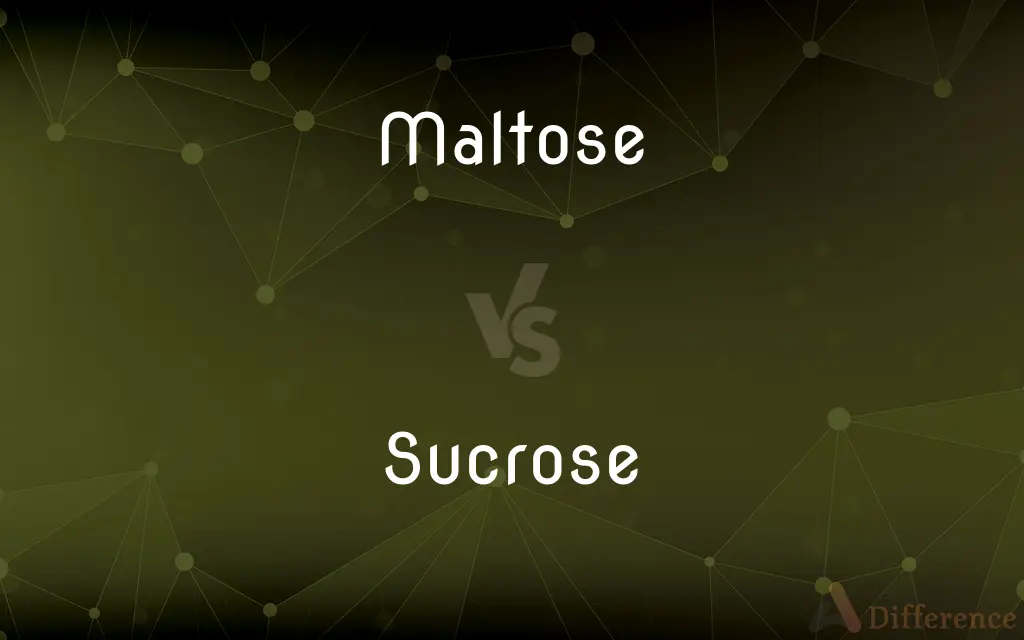Maltose vs. Sucrose — What's the Difference?
By Urooj Arif & Fiza Rafique — Updated on April 16, 2024
Maltose and sucrose are both disaccharides but differ in their sugar composition; maltose consists of two glucose units, while sucrose is composed of glucose and fructose.

Difference Between Maltose and Sucrose
Table of Contents
ADVERTISEMENT
Key Differences
Maltose, often called malt sugar, arises from the breakdown of starch, particularly during the germination of seeds like barley and in the brewing process. Sucrose, commonly known as table sugar, is naturally occurring in many plants and is the primary form of sugar refined for consumption.
Both maltose and sucrose are used as sweeteners, but maltose is less sweet compared to sucrose. Maltose has a moderate sweetness, which makes it suitable for specific food products like certain beers and breads, whereas sucrose is widely used in a variety of culinary applications due to its higher sweetness level.
The enzymatic breakdown of starches through amylase produces maltose, highlighting its role in both natural biological processes and industrial applications such as brewing and baking. Sucrose is extracted from sugar cane or sugar beets through a refining process that separates it from other plant materials.
In terms of digestion, maltose is broken down by the enzyme maltase into two glucose molecules, which the body readily absorbs. Sucrose is metabolized by sucrase, which splits it into glucose and fructose, each then processed in slightly different metabolic pathways.
Maltose tends to be less common in everyday diets compared to sucrose, which is a predominant sweetener in processed foods and beverages. This makes sucrose a significant dietary source of carbohydrates globally, whereas maltose intake is typically incidental to consumption of foods containing it as a byproduct of starch breakdown.
ADVERTISEMENT
Comparison Chart
Composition
Two glucose units
One glucose unit + one fructose unit
Sweetness
Moderate
High
Source
Breakdown of starch
Extracted from sugar cane or sugar beets
Usage
Brewing, baking
General culinary uses, sweetening
Digestion
Broken down by maltase
Broken down by sucrase
Compare with Definitions
Maltose
Common in fermented foods and beverages.
Maltose is a key sugar in the production of beers and malted drinks.
Sucrose
A disaccharide consisting of glucose and fructose.
Sucrose is commonly used as table sugar.
Maltose
A disaccharide formed from two glucose molecules.
Maltose is produced during the malting process in beer brewing.
Sucrose
The primary sugar used in cooking and baking.
Sucrose is used in cakes, cookies, and desserts for sweetness and texture.
Maltose
Digested by the enzyme maltase.
Maltase breaks down maltose into glucose units that are easily used by the body.
Sucrose
Naturally found in many fruits and vegetables.
Sucrose is abundant in sugar cane and sugar beets.
Maltose
Known for its role in the digestion of starch.
Maltose levels increase during the germination of cereal grains.
Sucrose
A significant source of calories in many diets.
Sucrose consumption is a major consideration in dietary planning due to its prevalence in processed foods.
Maltose
Less sweet than sucrose.
Maltose is often used in foods where a mild sweetness is preferred.
Sucrose
Requires the enzyme sucrase for digestion.
Sucrase splits sucrose into glucose and fructose during digestion.
Maltose
Maltose ( or ), also known as maltobiose or malt sugar, is a disaccharide formed from two units of glucose joined with an α(1→4) bond. In the isomer isomaltose, the two glucose molecules are joined with an α(1→6) bond.
Sucrose
Sucrose is made up of one molecule of glucose and one molecule of fructose joined together. It is a disaccharide, a molecule composed of two monosaccharides: glucose and fructose.
Maltose
A sugar produced by the breakdown of starch, e.g. by enzymes found in malt and saliva. It is a disaccharide consisting of two linked glucose units.
Sucrose
A crystalline disaccharide of fructose and glucose, C12H22O11, extracted chiefly from sugarcane and sugar beets and commonly known as table sugar. Also called saccharose.
Maltose
A white disaccharide, C12H22O11, formed during the digestion of starch. Also called malt sugar.
Sucrose
(carbohydrate) A disaccharide with formula C12H22O11, consisting of two simple sugars, glucose and fructose; normal culinary sugar.
Maltose
(carbohydrate) A disaccharide, C12H22O11 formed from the digestion of starch by amylase; is converted to glucose by maltase; it is an isomer of trehalose
Sucrose
A common variety of sugar found in the juices of many plants, as the sugar cane, sorghum, sugar maple, beet root, etc. It is extracted as a sweet, white crystalline substance which is valuable as a food product, and, being antiputrescent, is largely used in the preservation of fruit. Called also saccharose, cane sugar, etc. At one time the term was used by extension, for any one of the class of isomeric substances (as lactose, maltose, etc.) of which sucrose proper is the type; however this usage is now archaic.
Maltose
A crystalline disaccharide (C12H22O11) formed from starch by the action of diastase of malt, and the amylolytic ferment of saliva and pancreatic juice; called also maltobiose and malt sugar. Chemically it is 4-O-
Sucrose
A complex carbohydrate found in many plants and used as a sweetening agent
Maltose
A white crystalline sugar formed during the digestion of starches
Common Curiosities
Can maltose contribute to health issues?
Like other sugars, excessive intake of maltose can contribute to health issues such as dental cavities, weight gain, and metabolic disorders.
How does the sweetness of maltose compare to sucrose?
Maltose is less sweet than sucrose, which is why it is less common as a direct sweetener in foods.
What is the primary dietary source of maltose?
Maltose is primarily obtained from foods that involve the enzymatic breakdown of starches, such as in cereals and certain processed foods.
Is maltose suitable for diabetics?
Diabetics need to manage maltose intake as it directly influences blood glucose levels, similar to other sugars.
Why is sucrose more commonly used than maltose?
Sucrose is more widely used due to its higher sweetness and availability from sugar crops like cane and beet.
How does the body use sucrose?
The body metabolizes sucrose by splitting it into glucose and fructose, which are then used for energy or stored as fat.
Are there any natural sources rich in maltose?
Natural sources of maltose are not abundant; it is mostly found in germinating grains and as a byproduct of starch digestion.
What are the benefits of using maltose in brewing?
Maltose is beneficial in brewing for its fermentable sugar content, contributing to the alcohol and flavor profile of beers.
What role does sucrose play in plant life?
In plants, sucrose acts as a transportable form of energy from leaves to other parts of the plant where needed.
What are some processed foods high in sucrose?
Processed foods high in sucrose include candies, soft drinks, baked goods, and many types of desserts.
Share Your Discovery

Previous Comparison
Contig vs. Scaffold
Next Comparison
Animation vs. VideoAuthor Spotlight
Written by
Urooj ArifUrooj is a skilled content writer at Ask Difference, known for her exceptional ability to simplify complex topics into engaging and informative content. With a passion for research and a flair for clear, concise writing, she consistently delivers articles that resonate with our diverse audience.
Co-written by
Fiza RafiqueFiza Rafique is a skilled content writer at AskDifference.com, where she meticulously refines and enhances written pieces. Drawing from her vast editorial expertise, Fiza ensures clarity, accuracy, and precision in every article. Passionate about language, she continually seeks to elevate the quality of content for readers worldwide.














































